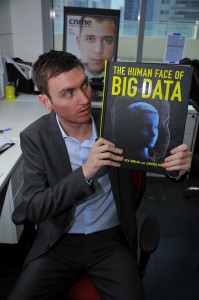The Human Face of Big Data, recently created by Rick Smolan and Jennifer Erwitt, is a real reference book triumph.
Working in IT, I come across my fair share of new releases, but not often do they come in the form of a book, so already I was in high spirits.
When this book was delivered to my desk, unexpectedly, I saw nothing but a giant package with legs waltzing towards me. I thought to myself, “wow, laptops have gone backwards,” however, it was The Human Face of Big Data, a book of fair size. Let’s clear this up early – at first glance I wasn’t sure why this book needed to be so big, ok, it’s about big data, a big topic, everything is big – I get it. But this isn’t train reading material. It’s about the size of a broadsheet paper but it weighs as much as a medium sized dog, after dinner. However, what I later learned is that this size is absolutely necessary for the content.
The book is filled head to toe with amazing high resolution images which are simply stunning. The scale of the photos and the way they’re presented is a real treat and testament to the photographers.
The format for this piece of work is extremely clever; a string of essays written by contributors on a broad scale of topics, highlighting how big data has an effect on everything. The book uses examples from aviation, finance, sport, science, healthcare, medicine, religion, security, crime, and technology. Each topic is supported by insightful quotes, statistics, photos, and infographics – short, simple, insightful information.
How I see it, most likely not how everyone else sees it, is that the creators have basically piled in snippets of information and research, shaken it up and laid it out. The result is a book absolutely crammed with information in digestible chunks, perfection in relation to reference material.
One section which interested me was concerning Facebook and some of the numbers which come with it. The book claims that 30 billion piece of content are posted daily (a large percentage courtesy of yours truly) and 2.7 billion likes or comments attached daily (an embarrassingly small percentage of which is aimed towards yours truly).
As well as this, 48 hours of video are uploaded to YouTube each minute, astonishing figures.
However, my favourite essay in the book was written by a journalist named A. J. Jacobs. He describes his relationship with technology which helps humans to self-track their fitness and health in everyday life. An extremely amusing piece, just planted in the middle of the book, a result of the shake and lay tactic previously mentioned no doubt, which talks through how even just having the presence of technology in our lives can dramatically change the way we live.
Jacobs tells of how when he first attached a pedometer to his waist, he started to seek out active challenges in day-to-day life in order to rack up the steps as if it was some kind of competition. Now, Jacobs sleeps with a device attached to his head to monitor his sleep pattern, a device which monitors his calorie intake, and a device which monitors his heart rate. Humans are now obsessed with tracking their activity like you would a machine. And technology allows us to do that, and this book points out why and how all with brilliant clarity and in wonderfully high resolution.
It’s a fantastic achievement and in my opinion, a brilliant way to get an insight into a major topic without having to be too tech savvy or IT enthused. The book lays out complex ideas and statistics in a coherent way with absolute ease. I had great fun going through it.
I passed the book on to four other people, and mentioned it in multiple conversations – that’s how I judge a good book. Usually, I only ever talk about my own work that much, this is far more worth reading.
“Big data could know us better than we know ourselves” – tell that to my dad.






